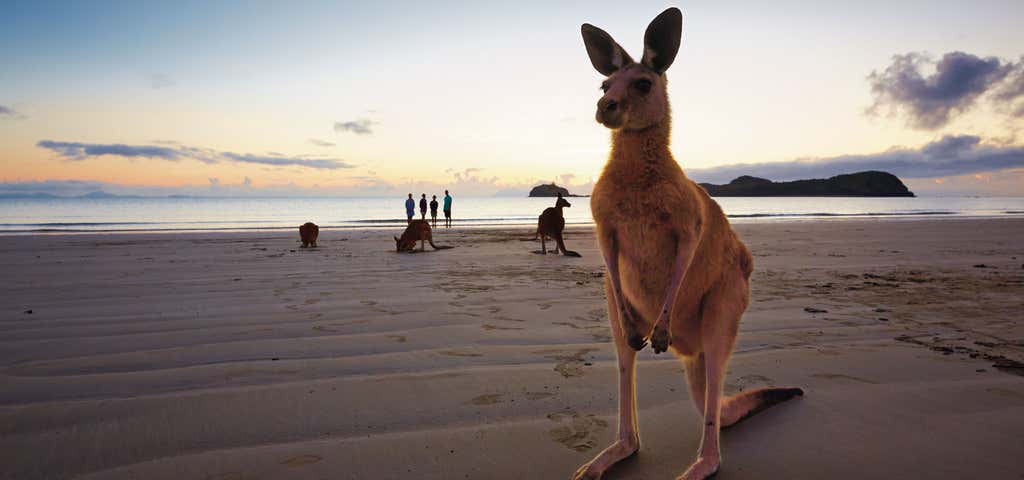It’s practically mandatory that on a visit to Australia you seek out some of Australia’s unique and super cute native animals. Let’s face it, who doesn’t want to tally up sightings of some of the world’s most unusual wildlife? From crocs to the cassowary, kangaroos to koalas, most of Australia’s native animals are endemic (found only in Australia). And there is no better way to see them than in the wild. Where they belong.
And there are some amazing places around the country where the animals gather so that, as long as you keep a safe distance, you will be lucky enough to see them going about their day. Head from north to south with us as we showcase the best of Queensland’s wildlife hotspots. Observe kangaroos, koalas, emus, dingoes, platypus, bandicoots, echidnas and all their native cousins with our top ten picks.
In Queensland’s far north, the biologically diverse Daintree Rainforest is home to the highest concentration of rare or endangered wildlife in the world. This 135 million-year-old forest, two hours north of Cairns, offers a high probability of spying endemic fauna.
Animals calling the Daintree Rainforest their home include tree kangaroos, musky-rat kangaroos, bandicoots, quolls and the keep-your-distance southern cassowaries. Add to this frogs, lizards, spiders, bugs, and birds and you can see why the Daintree is a must on any Northern Queensland itinerary.
No mention of Queensland is complete without talking about the Great Barrier Reef. This bucket-list worthy coral reef system is home to thousands of marine species, including turtles, dolphins, whales, sharks, and rays. It’s truly the world’s finest!
Exploring marine life on the Great Barrier Reef is easy – if you can narrow down your choice that is. Choose to swim, snorkel, dive, kayak, jet boat, sail, take a semi-submarine, liveaboard a yacht, hot air balloon ride or enjoy a scenic flight. Phew!
Access to the reef is typically from Cairns but you can connect all the way along the coastline from Cape York to Bundaberg. Airlie Beach, the Whitsundays and Port Douglas are popular alternatives to Cairns.
If you’re wondering where to spot Australia’s largest bird - the cassowary - you may be surprised to discover that it is where the rainforest meets the ocean in the Queensland Far North.
The flightless cassowary is endangered and sightings are rare (and also a little scary, these birds can be vicious). The intriguing prehistoric features of the cassowary make it worth your time to seek out.
While sightings can happen at a few beaches, Etty Bay is our pick. Stay in a cabin or at the caravan park if you want to enhance your chances. And please do remember to drive cautiously on the roads, especially in these parts. The rare cassowary often run across the road and we all need to be wary to ensure none are killed on the roads so that this crazy looking bird survives.
Visiting a sanctuary is a great way to experience Australian wildlife but there is nothing as magical as meeting a native animal in its own habitat. At Cape Hillsborough, expect just that as kangaroos join you for the quintessential tourism op – the sunrise photo. The remote shores, jagged coastline, and eucalyptus forest make for an awesome backdrop for that idyllic Instagram shot.
Considered one of the best beaches to encounter these furry marsupials and their buddy, the wallaby, it’s best to stay at Cape Hillsborough Nature Resort in prep for an early rise. The ‘roos head back to the shade once the sun has risen. And please remember not to feed them and to keep a respectful distance from them.
As shy as a couple on a first date, the endangered platypus is rarely seen on a Queensland trip but if you know where to look – and when to go – you’re in with a chance.
Eungella National Park is a forest-clad mountain midway between Cairns and Brisbane. It’s popular for its epic bushwalking opportunities, stunning vistas, and whopping 860 wildlife species.
Patience, peace and a trail of bubbles will lead to a platypus sighting at sunrise or sunset. Outside the park, the Platypus Bush Camp allows you the luxury of waiting for platypus from your hut bed!
Head to Fraser Island for dingo watching as their protected status there has made it one of the best places to spy these wild and rangy dogs. They roam the island at will, seeking food around dawn or dusk. The beach is their key territory and they can occasionally be seen dipping into the ocean to catch fish.
The pooch-like similarities lead people to forget that dingoes are wild animals. So please stay a safe distance, walk in groups, use caution when going into the bush and never feed them. If you do find coming face-to-face with a dingo in the wild seems a little risky, check out the Fraser Coast Wildlife Sanctuary.
While you’re on Fraser Island, also keep your eyes peeled for manta rays and dugongs from coastal views or on a boat trip.


"Fraser Coast Wildlife Sanctuary" — Photo Credit: Fraser Coast Wildlife Sanctuary
The legendary Steve Irwin was instrumental in bringing Australian animal awareness to the world. If you’re visiting the Sunshine Coast, don’t miss Australia Zoo. For koala lovers, it’s the best, most ethical place to nab a photo of you cuddling up to these eucalyptus-eating tree huggers.
Alongside koalas, you’ll also spot crocodiles, Tasmanian devils, kangaroos, snakes (it is Australia after all) and many more domestic and international wildlife.
Check out their rescue unit for wildlife emergencies and feel good that your ticket profits help fund conservation efforts across Australia.
You can no doubt locate a koala hanging from a gum tree somewhere on your Queensland travels but why leave it to chance when you can visit 130 of them? The Lone Pine Koala Sanctuary is 12km out of Brisbane and provides refuge for injured or unwell Australian wildlife.
With daily interactive shows, it’s justifiably a popular destination for visitors to the region. However it’s not all about the koalas, with 100 species of wildlife you’ll also visit wombats, emus, dingoes, kangaroos and more.
An often-overlooked treasure, Stradbroke Island is home to 450 native animals and is accessible by ferry from Brisbane. The isolation of the island and limited development has protected the majority of species in their unique ecosystem. You can expect to see kangaroos chomping down on dune grass at sunset or koalas hanging from gum trees, as well as wallabies, echidnas, and even bandicoots.
If you’re looking for marine life, the waters surrounding Stradbroke Island are resplendent with whales (June to November), dolphins and dugong. Head up Gorge Walk too if you want to combine a hike with a bit of manta ray or turtle spotting.


"Gorge Walk" — Photo Credit: Queensland.com
If you’re staying in the Gold Coast area then the Currumbin Wildlife Sanctuary is your go-to place for all Aussie animals (plus some overseas guests). If it is Australian and you can think of it then the breed most likely has a safe place at Currumbin.
On-site you can take photos with many of the animals (including a prickly echidna), watch the impressive Australian birds’ flight show or visit the wildlife hospital and see the good work they are doing there.
If you have extra time, the Currumbin Tree Top Challenge is not for the faint-hearted. Walk or zip line over 80 trees in an epic adventure.
Explore More Trip Guides
Western Australia’s Wonderful Wildlife
- 9 Places
- 39:16
- 2,160 mi
Whales, Wonderous Whales. And where to see them Queensland.
- 7 Places
- 25:42
- 1,256 mi
Whales, Wonderous Whales. And where to see them NSW.
- 12 Places
- 18:15
- 926 mi
Tasmania's Wonderful Wildlife
- 10 Places
- 12:56
- 574 mi












